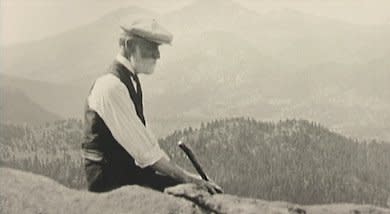This is the first of a six-part series introducing readers to- or maybe revealing some new, unfamiliar details to people already familiar with- the history of The Stanley Hotel
As February approaches, the ownership, but not the management, will change hands of this Estes Park icon. New things are coming to The Stanley Hotel, with exciting new learning opportunities for filmmakers, entertainment expansions, a horror film center and much more.
Although the future of The Stanley Hotel looks bright with a long road still ahead, the history of The Stanley Hotel stretches back farther than most things in Estes Park, even opening before Estes Park was an incorporated town.
In the second piece in the series, we will take a look at the history of the Stanleys. Who were they and what brought them to Estes Park? Why did they build such an ornate hotel in a fledgling rustic town? What was their impact on Estes Park then and how does that impact continue to be felt today?
F.O. Stanley, the man behind the idea for The Stanley Hotel. (Courtesy of The Stanley)
In the third piece, we will explore the history of the owners of The Stanley Hotel after the Stanleys were involved in the property’s management but before current owner, John Cullen, purchased the property. Who were those owners? What happened to the hotel in the years between the Stanleys and Cullen? What was happening in Estes Park and around the world that changed the direction of the hotel?
In the fourth and fifth parts, we will delve into the history of the Cullen years at The Stanley Hotel, a period that stretches from 1995 to 2023. These two articles will be broken down into 1995 to 2013, when the massive flood of that latter year devastated Estes Park, and 2014 to 2023. Why did he buy The Stanley Hotel? What changes, improvements and expansions did Cullen make at the hotel? What is Cullen’s impact on Estes Park? How has Cullen supported the community throughout his tenure as owner?
The final part will take a look at the future of The Stanley Hotel. In Nov. 2023, an announcement was made about a transfer of ownership but not management of the hotel to a non-profit. In Feb., these details will be finalized and plans will be announced about the near and long-term future of the property. This final piece will report on the exciting expansions and investments that are in the works.
The Stanley Hotel was built shortly after a time known as the Gilded Age. A result of the rapid expansion of industrialization and economic growth in the U.S., many wealthy families were created during this time, a period that roughly occurred between 1877 and 1900.
During this period and into the early 20th century, many wealthy and elite families of old and new money were building extravagant mansions. Dozens of homes were built across the U.S. to show off their wealth with opulence and impeccable styling inside and out. Mansions like Biltmore House in Asheville, N.C., which opened on Christmas Eve in 1895, The Breakers in Newport, R.I., which was completed in 1895, and the Nemours Estate in Wilmington, Del., built in 1909, emphasized the owners’ stature in society.
Hotels were also being built for the wealthy, with Old World luxury catering to overstated tastes in locations near mountains, beaches and hot springs. Mohonk Mountain House in New York, the Greenbrier in West Virginia and the Grand Hotel on Mackinac Island, Mich. were just a few of the examples of these fancy destinations.
The Hotel Boulderado, pictured on March 18, 2020, in Boulder, Colo. (Cliff Grassmick/Staff Photographer)
Even in Colorado, where the mountain air was touted for its health benefits, homes and hotels catering to this upper-class sprouted up across the state. Places like The Brown Palace in Denver, The Broadmoor in Colorado Springs, Hotel Boulderado in Boulder and Redstone Castle in Redstone, were built in the late 1800s and early 1900s.
The impacts of two world wars, the Great Depression and other economic events plus changing tastes, however, all had their effect on the sustainability of paying for large-scale homes. Many fell to the challenges of financial stability. Others were consumed by fire, with most being built with wood.
The history of The Stanley Hotel follows a similar path as these other opulent buildings, enjoying times of prosperity while also struggling with difficult financial challenges in some years. But a building is often more than a building, breathing life into a community and making memories for those who visit.
These articles will uncover some of that history and look at the impact the Stanleys had on Estes Park. The content will also look at how Cullen has rejuvenated and maintained a piece of American history for many future generations.






